Franks (3)
Franks (Latin: Franci): tribal federation on the north and east bank of the Lower Rhine, which created a late antique kingdom in France.
Chlodovech/Clovis
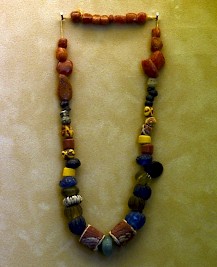
Chlodovech, or (as he is also known) Clovis, was the son and successor of Childeric. According to tradition, Chlodovech became king in 481, but there is room for doubt. The problem is our main source: Gregory, bishop of Tours and author of a very entertaining History of the Franks. It is inevitable that a historian who wrote a century after the events will make mistakes. In this case, the chronology is suspect: Gregory places the main stages of Chlodovech's career at five-year intervals.
Gregory claims that five years after the death of his father, i.e. 486, Chlodovech wrested the land between the Somme and the Loire from the son of Aegidius, Syagrius. Five years later – in 491 – the Frankish king was supposed to have beaten the Thuringii on the Upper Weser. Another five years later, in 496, Gregory reports that Chlodovech went to war with the Alamanni in the Alsace. It is obvious that we cannot take this chronology at face value, if only because Italian sources date the victory of the Alamanni to 507.
After this, Chlodovech pushed the Visigoths back from the Loire to the Pyrenees. Finally, Gregory states that the great conqueror died after a reign of thirty years, in 511. This date is demonstrably false, as the Book of Popes, the official collection of papal biographies, reports that Chlodovech was still alive in the year 513.
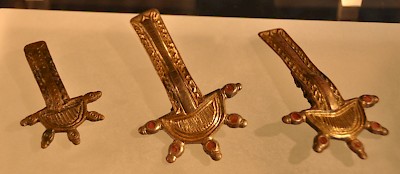
However, although we may question the chronology of Gregory’s historical work, it is certain that, at his death, Chlodovech ruled the entire region north of the Pyrenees, with the exception of the Rhône Valley, where the Burgundians still had an independent state. It is likely that Chlodovech first cooperated with the Frankish leaders in the Rhineland but later subjected them. We also know that he worked closely with the Christian Church in the last years of his life.
Gregory’s account can, again, not be relied upon because it is too clearly modelled on the legend of Constantine the Great. Moreover, Gregory himself refers to the fact that, at an earlier moment, Chlodovech had demanded respect for the property of the Church.note It is quite possible that Chlodovech always was a Christian and merely converted from Arianism to the Creed of Nicaea.
That being said, Gregory’s story nevertheless contains an element of truth, because from the time of Chlodovech’ government, the Merovingians and the Church would work closely together. The kings supported the Church and its missionaries, while the literate monks and bishops helped the king in the administration of state. One of the things they did, for example, was draw up Frankish Law.
It would fit Chlodovech's general administration: from the beginning to the very end, he presented himself as a Roman governor. He buried his father with a treasure of gold coins, all bearing legends of emperors recognized by Constantinople; he was governor of Gallia Secunda; he entered Tours as a Roman triumphator; he was recognized as consul. After the high position Frankish leaders had already achieved in the late fourth century, none of this was remarkable.
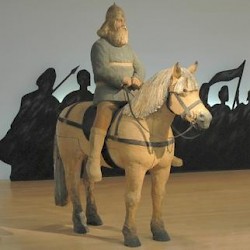 Morken, Reconstruction of a Frankish chief |
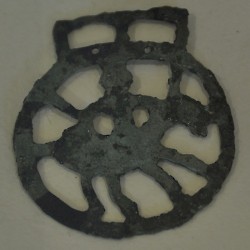 Frankish penditive from Arlon |
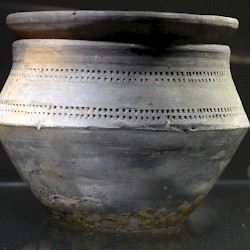 Grannum, Merovingian pottery |
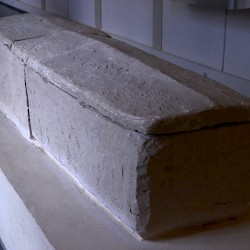 Glannes, Merovingian sarcophagus |
Further expansion
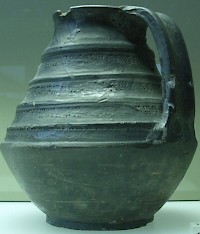
Chlodovech had four sons, who ruled the empire between them after the death of their father. We have no sources that tell us how this division of the Frankish kingdom worked out. We have to glean it from such items as letters, in which mention is made of who administered justice in a particular town. In spite of the sometimes uneasy relationships between the four brothers, the system worked. In 534, the Merovingian rulers together set off to fight the Burgundians, whom they defeated and subjugated. Two years later, they reached the Mediterranean.
The most powerful Merovingian ruler in the sixth century was Theodoric’s son and successor Theudebert (r.533-548), who ruled in the northeastern part of the Merovingian kingdom. When the Roman Emperor Justinian sent an army from Constantinople to reconquer Italy from its Ostrogoth rulers, Theudebert seized the opportunity to prove himself. In 539, he crossed the Alps and defeated both of the warring parties. Justinian even feared that the Frank would proceed to the Balkans, but Theudebert was too practical to allow himself to be tempted by such a venture.
And yet, something had changed. After his Italian campaign, he emphasized the Frankish autonomy by having gold coins minted, not with the image of the emperor, but with his own likeness on them. This made a big impression on his neighbors and Theudebert could expand his sphere of influence to the Saxons, Thuringii, and Bavarians. The Franks started to stress who they were: no longer Romans, like Childeric and Chlodovech, but an independent state. By the end of the sixth century, Gregory of Tours started to write his history of the Franks, introducing an accent that had been absent until then.
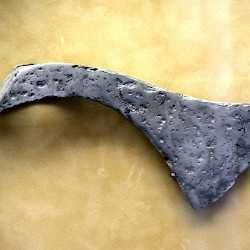 Villevenard, Francesca |
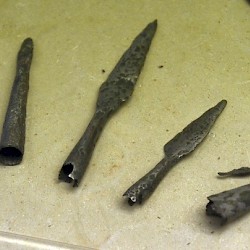 Villevenard, Frankish arrowheads |
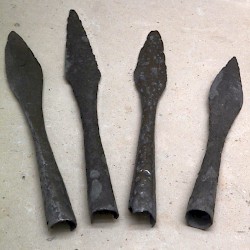 Villevenard, Frankish spearheads |
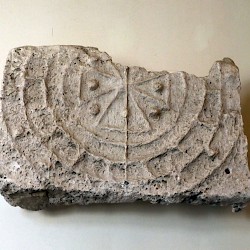 Villevenard, Fragment of a Christian sarcophagus |
Economy
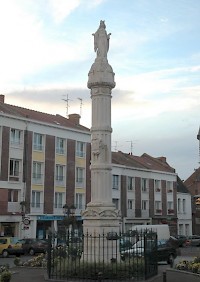
The power of Theudebert indicates the comparative prosperity of the Rhineland. This was partly because, just as in the fifth century, the economy of the region between the British Channel and the Lower Rhine was healthier than in the Mediterranean region, where things went from bad to worse in the sixth century. Wars followed each other in quick succession, a terrible epidemic raged, and the towns declined further. Conversely, the towns in the north prospered – at least more or less. Cologne was still a centre of the metal industry; in Trier and Maastricht, pottery was manufactured; iron was mined in the Ardennes.
Beyond the Somme, the Franks encountered a society where the peasants were serfs and government officials received their remuneration in the form of lands given on loan. These would also become important features of the society of the Middle Ages, which economically, socially, and politically differed considerably from that of (Late) Antiquity. Contrary to common belief, the origin of these changes is not to be found in the Frankish conquest. Serfdom and lands held in loan were not German inventions: the dynamics lay in the Roman Empire.
The royal house seems to have taken responsibility for the maintenance of the roads, for it has come down to us – although in a late source – that, at the beginning of the seventh century, Queen Brunhilda ordered the Roman roads to be repaired. Compared to the Mediterranean region, former Belgica was booming. There was commercial activity on some scale, and at the point where the River Lek branches off from the Rhine, close to the old limes fort of Mannaricum, the town of Dorestad grew to become one of the most important trade centres in Europe.
From Merovingians to Carolingians
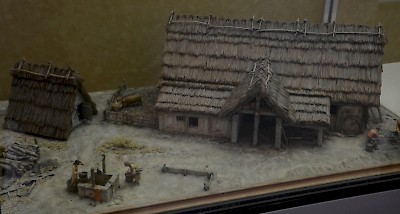
Several bishops propagated the Christian state cult: Amandus in Flanders and Lambert in Maastricht, while the Northumbrian missionary Willibrord built a small church within the remains of the ancient fort of Utrecht. In this way, the kingdom became better organized, and it remained comparatively strong when the Merovingian dynasty was replaced by the Carolingian, which also originated in Belgica. The best-known ruler from this family was Charlemagne (r.768-814). We have enough sources to establish that his kingdom was governed by about forty powerful families, among which the people from the northeast, called Austrasia, were overrepresented.
With the Treaty of Verdun in 843, which divided Charlemagne’s empire into three kingdoms, the unity of the Frankish Empire came to an end, and with it the central position that Austrasia had held for three centuries. Austrasia’s success was due to a factor that is stubbornly ignored by the authors of our written sources: the northwest of Europe remained relatively prosperous in a period of general malaise.
This prosperity had very, very deep roots: thanks to the first phase of the Roman presence in Belgica, at the beginning of our era, it had a varied economy; thanks to the crisis after the fall of the Gallic Empire, it had begun trading with the countries on the North Sea; thanks to being settled by the Franks in the middle of the fourth century, it was spared destructive invasions. When the Roman government disintegrated, Belgica and the Rhineland were ready and willing to take advantage of the situation.
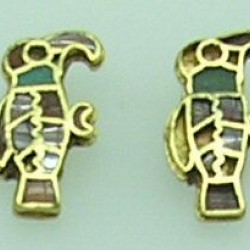 Cologne, Frankish bird-shaped fibulae |
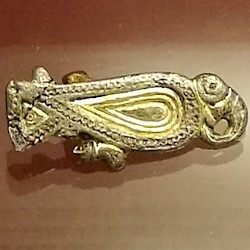 Dorestad, Bird-fibula of gilded silver |
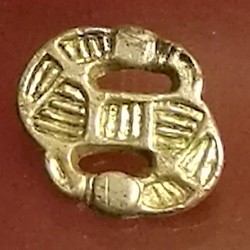 Dorestad, S-Fibula of gilded silver |
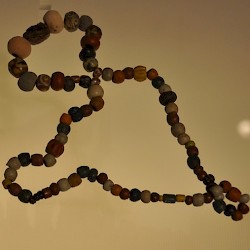 Necklace of a Frankish lady |